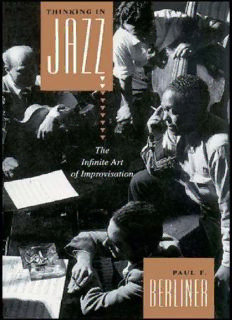
Thinking in Jazz: The Infinite Art of Improvisation (Chicago Studies in Ethnomusicology) PDF
Preview Thinking in Jazz: The Infinite Art of Improvisation (Chicago Studies in Ethnomusicology)
THINKING IN JAZZ The Infinite Art of Improvisation PAUL F. BERLINER The University of Chicago Press Chicago and London The University of Chicago Press, Chicago 60637 The University of Chicago Press, Ltd., London © 1994 by The University of Chicago All rights reserved. Published 1994 Printed in the United States of America 13 12 11 10 09 08 07 06 05 04 5 6 7 8 9 ISBN (paper): 0-226-04381-9 Library of Congress Cataloging-in-Publication Data Berliner, Paul. Thinking in jazz: the infinite art of improvisation / Paul F. Berliner. p. cm. — (Chicago studies in ethnomusicology) Includes bibliographical references (p. ), discography (p. ), filmography (p. ), and index. ISBN 0-226-04380-0. — ISBN 0-226-04381-9 (pbk.) 1. Jazz— History and criticism. 2. Improvisation (Music) 3. Jazz musicians—Interviews. I. Title. II. Series. ML3506.B475 1994 781.65′136—dc20 93-34660 CIP MN The paper used in this publication meets the minimum requirements of the American National Standard for Information Sciences—Permanence of Paper for Printed Library Materials. ANSI Z39.48-1992. Pictured on cover, clockwise from left: Billy Bauer (guitar), Eddie Safranski (bass), Charlie Parker, and Lennie Tristano (piano). eISBN: 978-0-226-04452-1 To the Artists of the Jazz Tradition CONTENTS List of Figures list of Music Texts Acknowledgments Introduction: Picking Notes out of Thin Air? Improvisation and Its Study PART I Initial Preparations for Jazz Chapter One Love at First Sound: Early Musical Environment Chapter Two Hangin’ Out and Jammin’: The Jazz Community as an Educational System PART II Cultivating the Soloist’s Skills Chapter Three A Very Structured Thing: Jazz Compositions as Vehicles for Improvisation Chapter Four Getting Your Vocabulary Straight: Learning Models for Solo Formulation Chapter Five Seeing Out a Bit: Expanding upon Early Influences Chapter Six The More Ways You Have of Thinking: Conventional Rhythmic and Theoretical Improvisation Approaches Chapter Seven Conversing with the Piece: Initial Routines Applying Improvisation Approaches to Form Chapter Eight Composing in the Moment: The Inner Dialogue and the Tale Chapter Nine Improvisation and Precomposition: The Eternal Cycle Chapter Ten The Never-ending State of Getting There: Soloing Ability, Ideals, and Evaluations PART III Collective Aspects of Improvisation Chapter Eleven Arranging Pieces: Decisions in Rehearsal Chapter Twelve Adding to Arrangements: Conventions Guiding the Rhythm Section Chapter Thirteen Give and Take: The Collective Conversation and Musical Journey Chapter Fourteen When the Music’s Happening and When It’s Not: Evaluating Group Performances Chapter Fifteen The Lives of Bands: Conflict Resolution and Artistic Development PART IV Additional Factors Affecting Improvisation, and Epilogue Chapter Sixteen Vibes and Venues: Interacting with Different Audiences in Different Settings Epilogue: Jazz as a Way of Life PART V Music Texts Appendix A: House Congressional Resolution 57 Appendix B: List of Artists Interviewed Sources Notes Discography Videography Bibliography Index F I G U R E S 3.1 Simple blues progression 3.2 Popular song form AABA: “I Got Rhythm” 3.3 Popular song form ABAB’: “She Rote” 3.4 Popular song form ABAC: “On Green Dolphin Street” 3.5 ii–V–I progression within different compositions 3.6 Harmonic turnbacks 3.7 Lead sheet samples of alternative harmony, “I Thought about You” 3.8 Elaborate blues progression 4.1 Barry Harris’s dictation of common bebop figure 5.1 John McNeil’s genealogy of representative trumpet players, with focus on the years 1945–93 6.1 The beat as an elliptical figure 6.2 Barry Harris’s rhythmic chanting exercises 13.1 Synchronization between walking bass and cymbal time-keeping patterns MUSIC TEXTS 1.1 Trumpet and saxophone notation key 1.2 Drum set notation key 3.1 Alternative representations of melody 3.2 Features of jazz vehicles 3.3 Various strategies in rendering melody 3.4 Alternative representations of harmonic form 3.5 Comparing harmonic movement within blues and AABA compositions 3.6 A sample of chord voicings 3.7 Embellishing chords 3.8 Substitutions: harmonic alteration chords 3.9 Substitutions: chords having different roots 3.10 Substitutions: harmonic insertion chords 3.11 Blues effects of substitute chords 3.12 Elastic interpretation of harmonic form 4.1 Joe Oliver’s “Dippermouth Blues” solo and its re-creations, 1923-37 4.2 Diversity of jazz ideas or vocabulary patterns 4.3 Sources of vocabulary 5.1 Dizzy Gillespie’s complex approach to rhythm 5.2 Different approaches to melodic invention 5.3 Features of different vocabulary stores 5.4 Approaches to invention for solo piano 5.5 Approaches to invention for solo drums 5.6 Personalization of a vocabulary pattern 6.1 One-noting improvisations 6.2 Rhythmic phrasing in relation to harmonic form 6.3 Animating the features of phrases 6.4 Unpredictable, playful use of rests 6.5 Elastic manipulation of rhythm 6.6 Melodic application of chord substitutions within blues structure 6.7 Barry Harris’s dictation of scale transformation by chromatic and mordent ornamentation 6.8 Charlie Parker’s practice of pivoting 6.9 Barry Harris’s derivation of rules from Charlie Parker solo 7.1 Blues structure of improvised phrases 7.2 Sample of melody rendition and its subsequent quotation 7.3 Patterns combined with diverse harmonic backgrounds 7.4 Displacement and transposition of vocabulary within different compositions
Description: